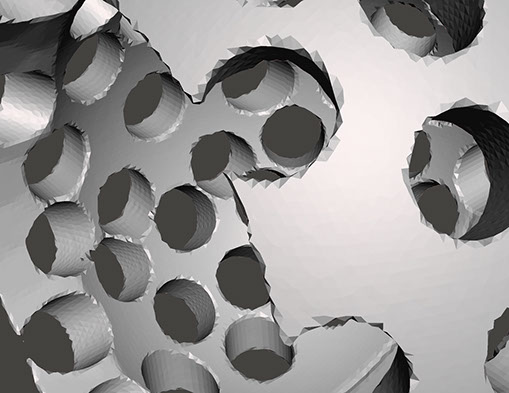Species: Actinomma Inerme: Aquatic Ancient Alien
Student: Zoe Darlington
Information:
It comes as no surprise that the sea is filled with awe-inspiring, alien creatures. However we often forget to consider the smallest ones, like phytoplankton, although they are some of the most ancient and revealing of the condition of our environment. One species of phytoplankton which I find particularly inspiring and strikingly geometric is called Actinomma Inerme, a microscopic creature made up of three concentric spherical shells covered in circular holes and held together by sword-like radial rods.
Actinomma Inerme are one of numerous species of radiolaria, which are aquatic protozoa often distinguished by two features. First, by the opalescent silica skeletons which many species of radiolaria possess. Second, radiolaria are typified by the separation of their anatomy into a central capsule containing their endoplasm, and their ectoplasm surrounding that central capsule. While these general characteristics (as well as radial symmetry, hence the term ‘radiolarian’) are shared by most radiolaria, there is an immense amount of physical variation between species.
Vast variation is predictable when we consider that radiolaria have appeared at all depths in oceans, seas, bays, and fjords all over the world, and have existed for about 600 million years (we can find them fossilized in rocks from the beginning of the Paleozoic era, as well as drifting along in today’s ocean currents).. Their unique, durable, crystalline skeletons have been an important factor to their survival and has helped contemporary scientific investigation, whether that be dating rock and sediment, studying climate change, or even researching cell growth and tumors. The amount of formal complexity and diversity which these microscopic single-celled organisms possess still astounds scientists, making their anatomy a fairly popular area of research.
Works Cited
Kling, Stanley A., and Demetrio Boltovskoy. “What are Radiolarians?” Radiolaria.org. Web. 27
Jan. 2018.
University of Oslo, Faculty of Mathematics and Natural Sciences. "New insight from the
wonderful world of radiolaria." ScienceDaily. 9 August 2016. Web. 28 Jan. 2018.
Waggoner, Ben, Manish Asaravala, Hayley Lam, Stephanie Litty, Jason Phillips, Ting-Ting Wu.
“Morphology of the Radiolaria.” University of California Museum of Paleontology. 5
May 2000. Web. 28 Jan. 2018.
